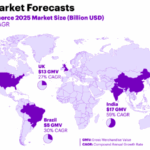The landscape of retail sales has been undergoing a significant transformation in recent years, with the rise of e-commerce playing a pivotal role. The impact of the global pandemic further accelerated the shift towards online shopping, as consumers sought convenience, safety, and a wider range of choices. In a remarkable development, online sales have consistently accounted for 25% of total retail sales over the past three months. This sustained trend signifies a profound change in consumer behavior and highlights the growing dominance of online sales in the retail industry.
The Rise of Online Sales:
Over the past decade, online sales have experienced exponential growth, reshaping the way consumers browse, purchase, and receive products. The convenience of shopping from the comfort of one’s home, the ease of comparing prices and reading reviews, and the ability to access a vast array of products from around the globe have propelled the popularity of online shopping. With advancements in technology, secure payment gateways, and efficient logistics networks, e-commerce has become a formidable force in the retail sector.
The Impact of the Pandemic:
The global pandemic presented unprecedented challenges for brick-and-mortar stores, forcing many businesses to temporarily close their doors or operate with limited capacity. As consumers adhered to social distancing measures and stayed home, online shopping emerged as a lifeline for retailers and consumers alike. The convenience, safety, and contactless nature of online transactions became crucial factors that fueled the surge in e-commerce sales.
Consistent Trend of 25%:
What sets the recent trend apart is the sustained level of online sales, consistently accounting for 25% of total retail sales over the past three months. This indicates a fundamental shift in consumer behavior and preferences. The previous perception of online shopping as a niche market or a temporary phenomenon has been shattered, as consumers increasingly embrace the benefits and convenience offered by e-commerce platforms.
Factors Driving the Consistent Trend:
Several factors contribute to the ongoing trend of 25% online sales in retail:
Convenience and Accessibility: Online shopping offers unparalleled convenience, allowing consumers to browse and purchase products at any time, from anywhere. The ability to shop 24/7 and have products delivered to their doorstep appeals to modern consumers’ busy lifestyles.
Expansive Product Selection: E-commerce platforms provide access to a vast range of products, surpassing the limitations of physical stores. Consumers can explore niche markets, compare prices, and find unique items that may not be available locally.
Competitive Pricing and Discounts: Online retailers often offer competitive prices and attractive discounts, making it enticing for consumers to make purchases online. The ability to compare prices across multiple platforms ensures that customers can find the best deals.
Personalized Recommendations: Advanced algorithms and machine learning technology enable online retailers to provide personalized product recommendations based on consumer preferences and browsing history. This tailored approach enhances the shopping experience and increases the likelihood of conversion.
The Future of Retail:
The consistent trend of online sales comprising 25% of total retail sales is indicative of a larger shift in the industry. It is clear that the e-commerce sector will continue to play a significant role in the retail landscape. As technology continues to evolve, we can expect further advancements in areas such as augmented reality, virtual showrooms, and improved logistics networks, further enhancing the online shopping experience.
Conclusion:
The sustained trend of online sales representing 25% of total retail sales over the past three months underscores the growing dominance of e-commerce in the retail industry. As consumers increasingly embrace the convenience, accessibility, and wide selection of products offered by online platforms, retailers must adapt their strategies to meet evolving customer expectations. The future of retail lies in a harmonious blend of online and offline experiences, where businesses leverage the strengths of both channels to create seamless, personalized shopping journeys for consumers.










